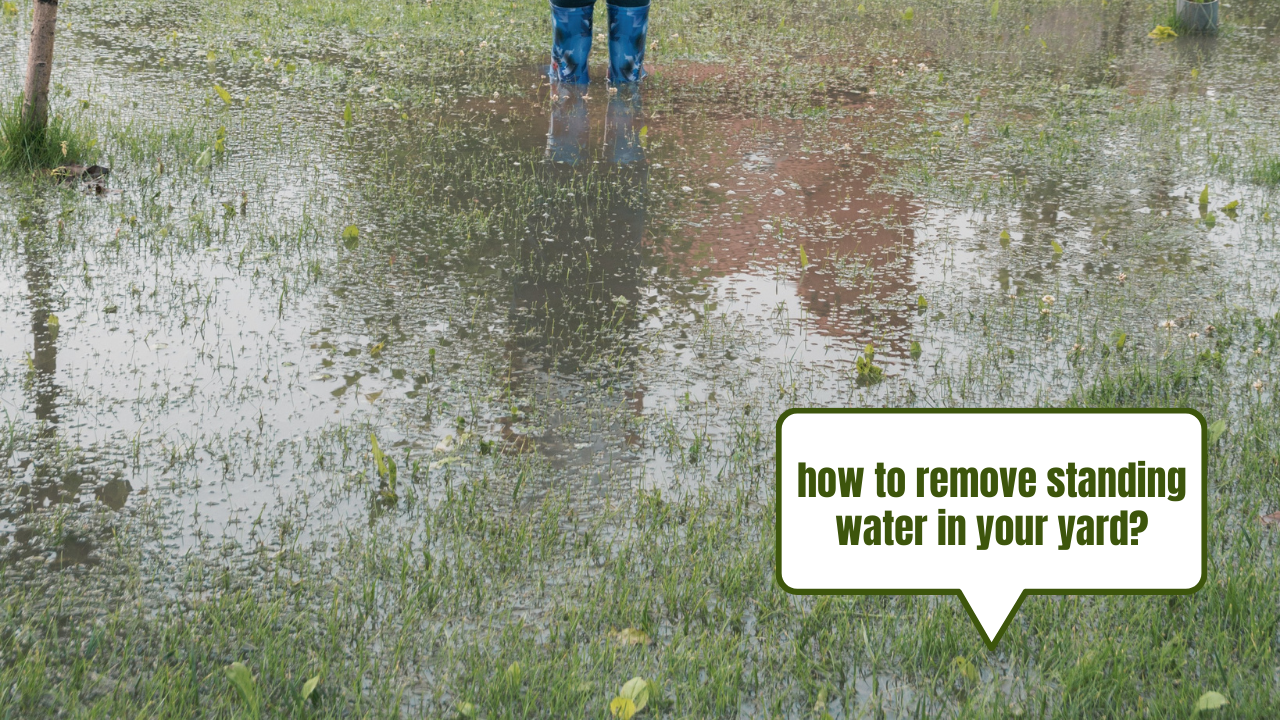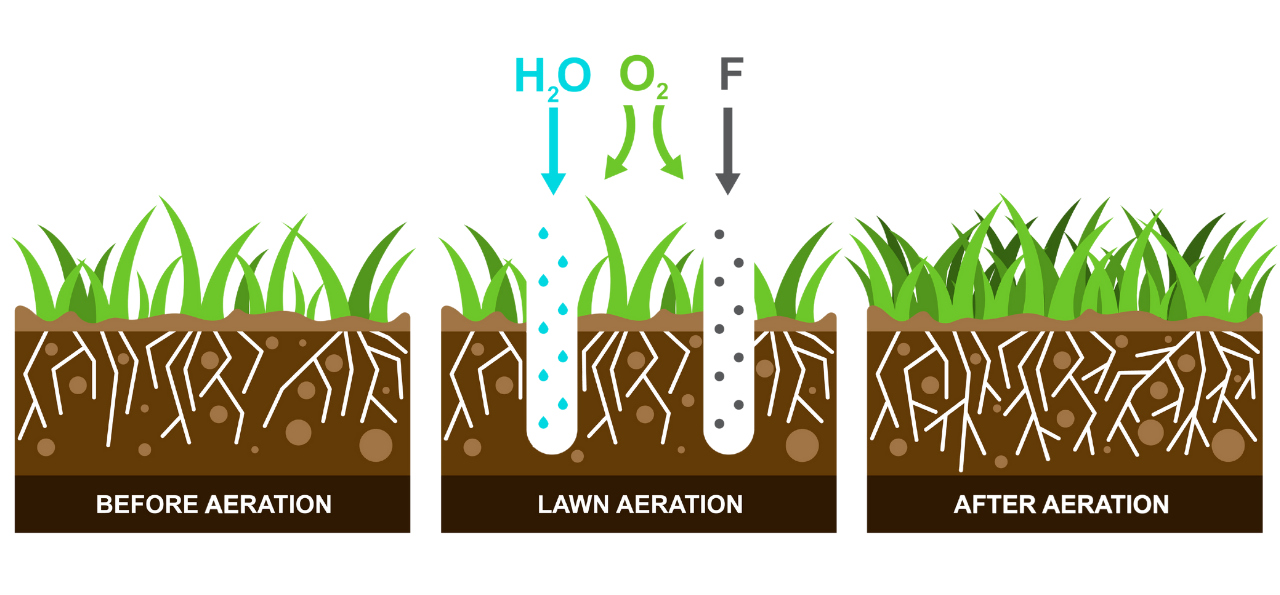There's nothing quite as frustrating as spotting a puddle of water surrounding your yard– especially if you know it's not because of a previous rainshower. Even if you follow a seasonal yard maintenance schedule, you may still wonder at some point: How do I get rid of standing water in my yard?
Remember that your backyard is one of your pride and joy as a homeowner. If it is in decline, it can be a huge disappointment to you and your visitors and neighbors. When overlooked, standing water in your yard may lead to possible mold growth, issues with the foundation, and lawn or landscaping issues.
So once you notice that your yard is currently saturated with water, it's best to fix the problem at once. Let's walk you through how to fix a yard that holds water with expert-backed, proven methods.
10 Ways to Get Rid of Standing Water in a Yard

Clearing standing water in the yard (especially after a heavy downpour) can be labor-intensive and time-consuming. Most people wait until the water has evaporated before they even want to deal with the issue. After determining the exact cause of the puddle of water in your backyard or garden, here are some proven methods you can try to get rid of the excess water.
1. Re-grade
Fortunately, landscape pros can help survey the trouble spots of your lawn (including the channels and the natural drains). Once they're done with the survey, they can determine the areas of your lawn that require re-grading. Ideally, completing your lawn before fixing the pooling water issue in some parts of your backyard is best.
2. Adjust Your Watering Schedule
One poor maintenance activity is overwatering, which results in standing water issues. Here are some things to remember to avoid watering your lawn a bit too much, regardless of whether you are watering it by hand or using an automatic sprinkler system.
When you observe any of these signs, you may be better off toning down your lawn watering schedule. Ideally, water your lawn between one and two inches of water every week.
3. Dethatch
In most cases, it's best to clear your yard of any thick thatch layer– as it may be why it doesn't drain properly. You can use a dethatcher or a lawn rake to help you get rid of the excess debris. Also, use a bag (or mulch feature) to avoid leaving behind heavy debris patches as you mow. (Related: What are the Pros and Cons of Lawn Dethatching? (A Comprehensive Guide))
It's likely that you have standing water pooling in your yard because your soil cannot properly soak it. Cases like these often boil down to excessive thatch layers (more than half an inch or so). Remove thick layers of dead plant matter for your lawn's benefit!
4. Aerate Your Lawn
After removing debris, it's time to use a lawn aerator to poke tiny holes in your yard's surface. This process breaks up compacted soil so the air, nutrients, and water can easily reach the grassroots. Ideally, ensure that the holes are at least four inches deep with a two-inch spacing between them. Homeowners without any aerator machine can contact local landscaping professionals to avail of their expert services.

If you have compacted soil on your lawn, chances are it won't soak in water as much as you'd want it to. As such, opt to regularly aerate your yard once in the fall or before winter. You can also schedule it in the spring, once the grown has been thawed. (Related: Aerating vs. Dethatching: Which is Better for Your Lawn?)
5. Give Your Soil a Boost
If you're dealing with stiff/sticky soil in your lawn that only pools water over time, you may consider breaking up the ground using tools such as a rake or shovel. Also, add compost, mulch, or manure for further boost.
6. Find the Hardpan
Homeowners with a hardpan no more than a couple of feet thick can break up their yard soil with a mere garden shovel. Just ensure to give it ample time to dry out completely. This may be harder if the ground is covered with grass, so you may need to replace brown patches of your yard with new grass seed. If you can't break up the hardpan completely, hire a professional contractor to drill through the soil for you.
7. Extend Downspouts
Those with a plant bed surrounding their home or landscape featuring rocks and an artificial border may have trapped water in the gutters. To help divert this water away from your home, you can extend the downspouts or the sump pump drain pipe. In most cases, this may solve your drainage issues.
8. Raise the Soil
Homeowners who struggle with their landscaping needs due to a high water table may opt to build raised beds, primarily for the benefit of their plants. You’ll benefit the most from shallow-rooted plants and flowers, as these can thrive in a standing water environment.
9. Install a French Drain
A French drain helps you direct water away from home, and fortunately, it can be constructed quickly and easily. Start by digging a trench in the lawn with deep holes as you direct the water near a dry well or a storm drain. Once the water is diverted, it will eventually drain into the surrounding soil. You can also fill the trench with gravel before placing a perforated pipe (made of plastic) at the base.
10. Create a Rain Garden (Bonus)
As the adage goes, if you can't beat it– you might as well embrace it. In this case, plant a rain garden to welcome the wet spots in your yard. You can consider the wet spots on your lawn as an opportunity instead of a problem. These can add something new to your yard and take it to the next level!
Frequently Asked Questions (FAQs)
Is standing water dangerous?
Yes, standing water presents several health risks, including the existence of rodents, insects, and bacteria that carry diseases. It also makes the ideal habitat for mold, algae, pathogens, mosquitoes, and other pests. You might also become vulnerable to harmful chemicals and injuries from floodwater and pooling water.
What are the leading causes of standing water?
Standing water is mainly caused by low sections in your yard, improper watering methods, and problems with your soil’s drainage.
Does standing water impact my lawn?
A soggy lawn invites disease and bald patches. Dollar spot, fairy ring, and red thread are a few fungal diseases that can develop in grass that is frequently wet. It is challenging to treat these diseases, and fertilizer makes them worse. If a disease requires you to stop using fertilizer, your lawn will suffer from a lack of nutrients. Before you encounter problems, improve the drainage in your yard to combat fungal diseases at their source.
Why do I have standing water in my yard?
Non-porous soil and low sections in the yard are the leading causes of standing water because they make the water accumulate rather than flowing into the surrounding soil. High foot traffic and excessive lawn thatch might also hinder your yard's capacity to drain water properly.
What diseases can you get from standing water?
Insects, animals, and germs that bring harmful diseases like legionella and E are brought by standing water. This includes E. coli, West Nile virus, pneumonia caused by pseudomonas, and nontuberculous mycobacteria. Additionally, stagnant water can result in gastrointestinal diseases, infections, tetanus, and skin rashes.
How do you fix standing water?
You can solve problems with standing water by putting up a French drain and dry well, aerating and dethatching your soil, watering more efficiently, downspouts extending, yard re-grading, increasing compost, and making raised plant beds.
